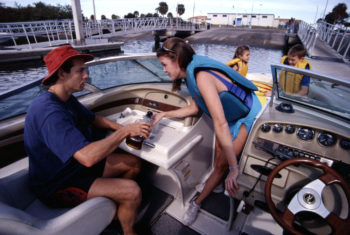Proper boat trailering requires practice and a routine so you’ll avoid misadventures and be courteous to others waiting their turn.
Having the proper tow package or correct hitch to go with a towing-capable vehicle is crucial. Check with the dealership and the trailer manufacturer to make sure vehicle, trailer, and vessel are compatible.
Driving with a boat or jet ski attached to a trailer is a skill that comes with time. Head to an empty lot and drive slowly, noting it takes more time to accelerate, turn, and brake. Observe how wide you need to turn and when you must start turning to avoid jumping a curb or median. Run through backing up until used to turning the steering wheel in the opposite direction to the way you want the trailer to turn. Repeatedly accelerate onto a high-traffic road to see how long it takes, and gauge the time to reach a complete stop.
After your off-water rehearsals, it’s time to head to the water. As a courtesy to other boaters, don’t go at prime time — practice efficient launching and retrieving of your vessel in off-hours and at empty ramps. Commit to some additional practice time after your first outing, so you’ll soon be both efficient and speedy enough to not delay and irritate fellow boaters.
General steps at a ramp:
- Check the vessel thoroughly to make sure no damage occurred on the trip.
- Remove supports, raise the lower unit, remove tie-downs, and ensure the winch is properly attached and locked into position.
- Check that the drain plug is in and secure.
- Disconnect the trailer lights.
- Attach a line to both stern and bow to grab while launching.
- Check the launch area for hazards including broken concrete, slippery oil or soap suds, spilled gas, and a steep drop-off.
- Start backing up, but stop before your tow vehicle’s rear wheels reach the water.
- Set parking brake and place chocks behind the rear tires.
- Have a companion hold on to your boat’s bow and stern lines.
- Disconnect the winch hook and line from the bow. When ready, lightly push the boat off or slowly back off the trailer.
- Lower the engine, run the blowers, check for fuel and other leaks, and start the motor.
- If others are waiting to launch, finish loading the boat away from the ramp.
The steps you take to retrieve your boat are essentially the opposite of what you did to launch it, noting any differences in conditions at the ramp upon returning. Keep in mind that time in the sun and on the water takes a toll, so when reattaching the boat to the trailer, ensure everything is secure and working, including the trailer lights.
Courtesy is always important in shared areas, so follow any posted rules, be mindful of traffic flow, dispose of trash and recyclables properly, and offer assistance if a fellow boater is struggling. Unload away from the launch area and don’t wash down and clean your boat or drain it while others are waiting.
If you boat in different bodies of water, cleaning up should be more than a quick wash and rinse. To prevent the spread of aquatic hitchhikers, including tiny organisms and microscopic larvae, thoroughly wash and dry everything that was touched by the water (that may include you and your dog, too).




